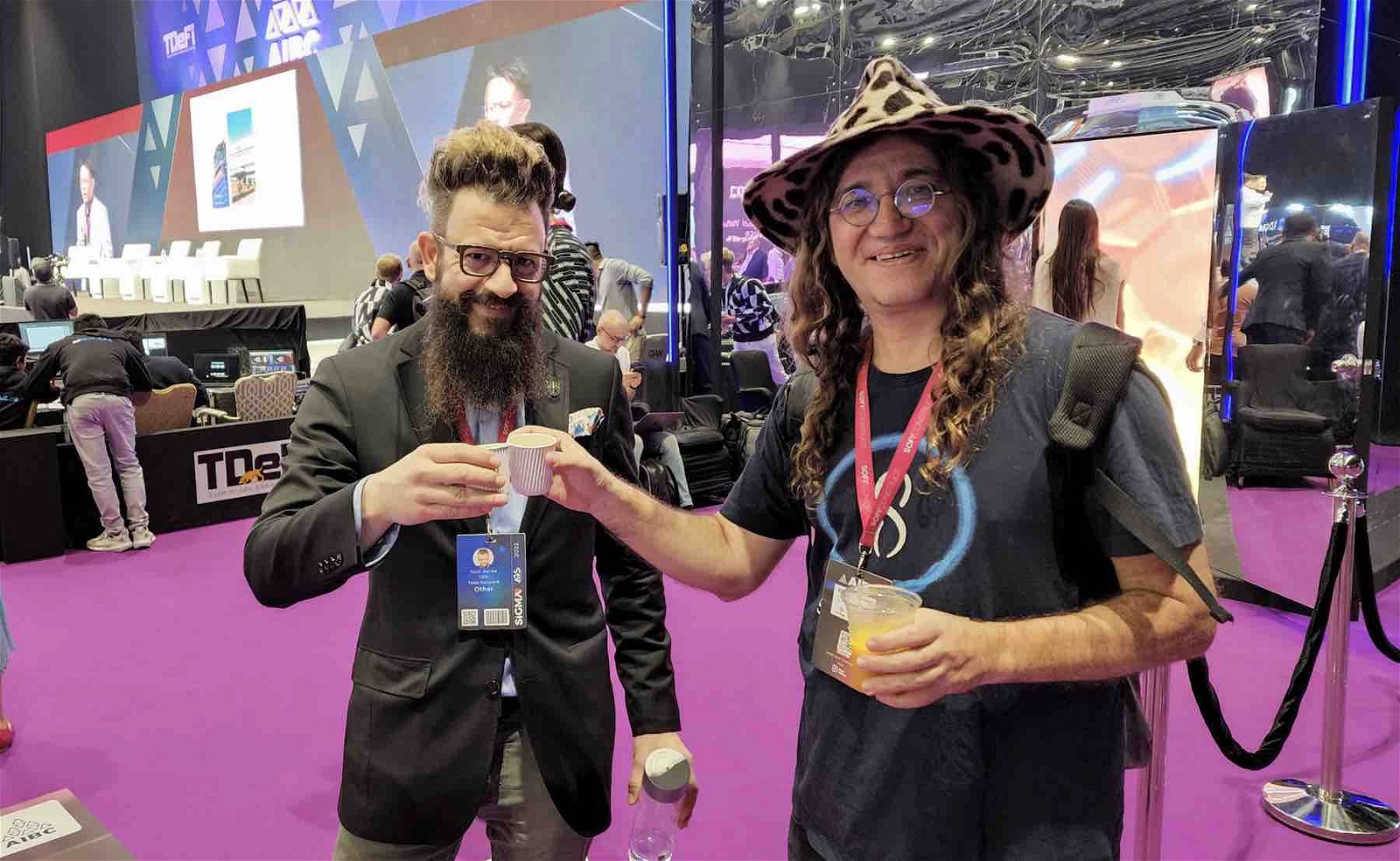A new company called HyperCycle is enabling artificial intelligence systems to connect in an unprecedented fashion, allowing them to cooperate and compete at the smallest modular levels and bringing the world closer to–and ensuring a safer–global AI network.
Although the idea of a worldwide AI that can work without human intervention is often portrayed in science fiction as a potential doomsday scenario, the minds behind HyperCycle say their approach is just the opposite.
In fact, they say HyperCycle is designed not only to help bring this type of generalized AI to life but that it may very well be the one sure architecture that also provides the security and reliability such a system will require to ensure humanity benefits from a decentralized AI system, as opposed to facing a technological doomsday scenario.
The Idea of Artificial General Intelligence and the Birth of HyperCycle
The founder of HyperCycle, Toufi Saliba, says the ideas behind this potentially earth-changing undertaking are not new but have been growing for nearly a few decades amongst the world’s top computer scientists.
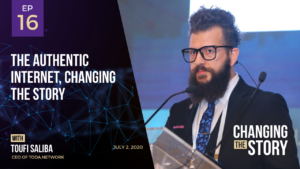

“I first introduced AI Decentralized in 2013 and subsequently to and through ACM* in 2017,” Saliba explained in an email to The Debrief “[and] my cofounder [Dr. Ben Goertzel] coined the term AGI in 2003.”
Short for Artificial General Intelligence, AGI has become somewhat of Holy Grail for engineers and programmers working in the exciting yet controversial field of blockchain. That’s because, in its current form, blockchain offers a number of advantages, primarily in information and financial/transactional security, while also facing a wide range of real-world challenges.
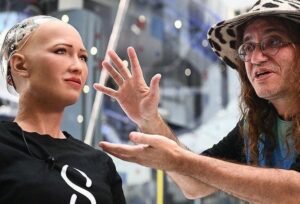

Among the challenges of current blockchain systems (like cryptocurrency) are the massive amounts of friction as they have quickly become a third party in transactions. Regardless that they claim decentralization amongst the ledgers, the fact remains two or more transacting parties suffer from depending on third parties (time and money)
High-performance computing systems (HPCs) used by large corporations and government entities around the world are growing rapidly to convert potential power (electricity) to useful intelligence.
“Connection and interactions existed for a long time with or without HyperCycle; however, certain types of interactions that exchange value have tremendous amounts of friction,” explained Saliba. “The friction in those interactions may not be significant for us humans, especially when you look at a single interaction. When two or more AI modules exchange values, they need the response A- Immediately and B- Without a cost that is comparable and sometimes higher than the value itself.”
As an example, Saliba points to the performance of HPCs. If optimized for performance, Saliba notes that a single medium-size HPC may require as many as 26 million interactions per second to partake in the global brain. Furthermore, for the whole system to be energy and computationally-efficient, Saliba says that those 26 million interactions had “better respond in milliseconds and have aggregate net/net cost of less than $1 (for the entire $26 million).”
Unfortunately, as the co-founder of HyperCycle points out, this kind of efficiency is currently not possible. Not because of the lack of engineering skills, we have had many boat engineers before cars. But, he notes, about a decade ago, he began developing a communications protocol that later was referred to as Toda/IP. It is specifically designed to enable such low-cost interactions. It’s a critical breakthrough, and one he says will be key to moving the idea of artificial general intelligence from concept to reality within our lifetimes.
“The main breakthrough here is done by Toda/IP; with HyperCycle, we are simply implementing it along with other components,” Saliba told The Debrief. “Effectively [HyperCycle is] putting all these pieces together.”
What is Artificial General Intelligence?
When engineers and coders talk about Artificial Intelligence systems, they often reference localized systems that use machine learning technology to solve problems that are too complex and time-consuming for humans to do the old-fashioned way.
“The internet of AI, aka cooperative AI, where AIs can cooperate at the smallest modular level, will introduce certain capabilities that are not currently provisioned, and certainly unprecedented,” said Saliba. “Imagine SIRI and Alexa both are cooperating behind the scenes to provide you with the best outcome.”
For a more specific, granular example, think about a localized Optical Character Recognition (OCR) AI that is designed to take analog text and convert it to a digital signal. In its current iteration, an OCR program uses its knowledge base to convert text as efficiently as possible. Still, it is not only limited to that data set but to certain intelligence that is missing out on so many others around the world. As noted, this is far from ideal. It is not cooperative
Instead, not only localized but can seamlessly and efficiently communicate with other AI systems to improve the accuracy and efficacy of their tasks.
“At a modular level, think of an English OCR subcontracting a few AI translators and an AI Chinese OCR to increase the accuracy of a job that it needed to do, which included, for example, comments in Chinese,” says Saliba. Such a system would, ideally, work with other AIs designed to convert Chinese characters into the digital environment. This is the basic idea behind cooperative AI as opposed to current siloed AI.


Still, as previously noted, this is extremely time and energy-consuming if done using current communication networks. But with TODA/IP and HyperCycle, the transactional “cost” is dramatically reduced by taking advantage of a decentralized approach, where individual AI systems can work together without having to go through a centralized server for each and every transaction.
Saliba and his co-founder, Dr. Goertzel, compare this to the neurons in a human brain working across connections as opposed to having to connect to a central part of the brain for each and every transaction. This is exactly how the human brain works. So, in effect, the HyperCycle approach, at a high level, compares its methods to how certain elements in nature operate. This comparison is simply used to ensure the vast majority of any audience will realize it’s possible.
“Neurons do not check with the central brain when effectuating a transaction,” Saliba told The Debrief, “the synapses do that job and do it really well.”
How Does HyperCycle work?
“To go through the “How” In a simple answer is certainly not possible,” says Saliba, echoing a sentiment often conveyed by engineers and visionaries whose work is anything but simple, “but we can try.”
First, Saliba notes that his Toda/IP “goes down to the structural elements of the internet” to the actual network packet levels. “This does not mean it is mutually exclusive to other methods/tools nor on its own is sufficient,” he cautions, “but it does mean it is absolutely necessary.”
For those unfamiliar with the ins and outs of internet transfer protocols, Saliba explains the idea of sharding, or the reducing of data down and down again until you reach the core packet of data, which is at the heart of how his Toda/IP internet protocol can enable the first steps toward an AGI.
“Sharding can give higher supply, but when demand reaches that supply, you must shard again and again and again until you can technically no longer shard. You get to the smallest possible shard, (which) is the network packet that has existed everywhere on the planet since the inception of the internet.”
Of course, in any new approach like Toda/IP, one wants to not only create a mechanism for communicating at the individual packet level but, as Saliba notes, “you probably don’t want to have a new internet but want the solution to be backward compatible.” And that means operating at a maximum of 64 KB per HyPC packet. Effectively any internet network can operate as it views them as TCP packets. Hence the backward compatibility goes back to the 1970s, and the interoperability is by construct, with no need for 3rd party either.
“Guess what,” says Saliba, “that is where we have started in Toda/IP, so you don’t ever need to shard more than that; it’s already sharded to the bones.”
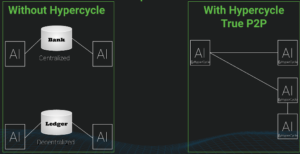

It is this new approach to managing and transferring data packets across a global network that allows Toda/IP and HyperCycle to operate efficiently and at the individual transaction level, similar to the way individual neurons within the human brain operate. In effect, by sharding the data to the smallest packet while also maintaining backward compatibility, HyperCycle is building an infrastructure that essentially operates like those synapses.
“Similar to humans, when contracting or subcontracting other humans, you must have something of value to exchange,” says Saliba. That process, he explains, relies on something he built directly into Toda/IP known as a “Sato-Server.” Without driving too far into the weeds of how data transfer works within a networked system, Saliba says this Sato-Server “is capable of porting any value that is positively perceived by both parties of an interaction/transaction.”
“The Sato-Server is a specific type of a Toda File, aka Toda Packet,” Saliba explains. “It has the characteristics that in each block of time, it can only belong to a single cryptographic public key.”
Saliba notes that every time the Sato-Server changes its owner, something global gets triggered (global hash). While the entirety of the proof is necessary to be kept with the receiver, a deterministic summary of it is kept inside the Sato-Server.
“This global hash is crucial, and there is no logical way around it,” Saliba told The Debrief. “If anyone tells you otherwise, [they] would either be lying or simply don’t know what they are talking about. We have seen a lot of those over the years.”
How Does HyperCycle compare to and improve on current blockchain technology?
Among the key benefits of current blockchain technology is the ability to prove ownership of a given item. In fact, this core ability is what has fueled much of the Non-Fungible Token (NFT) collectibles marketplace. Unfortunately, the current blockchain is extremely energy and time inefficient, especially since it is dependent on a “ledger” to track and effectively verify any and all ownership transactions within the blockchain. This inefficiency has stoked fears among environmentalists who see blockchain as both highly necessary to a future global AI and as something so energy inefficient that it may not be worth the cost to the planet.
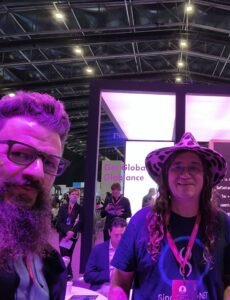

Among those core concerns is the use of a ledger by blockchain systems to keep track of each and every transaction and its need to be copied and replicated across the entire network. This consumes a ton of power and, according to the people at HyperCycle, is mostly unnecessary so long as the proofs remain global in every block of time, ala Toda/IP.
“That’s a misconception that almost every so-called blockchain expert would tell you that it is the case. It is not true,” Saliba explains. “The blockchain is sufficient to have the proof by constructing a blockchain that could use a ledger, but it does not have to. A blockchain is simply chained proofs of events that are temporarily coupled.”
Saliba says his Toda/IP works without a ledger but still maintains all of the benefits of traditional blockchain and more. This is a critical improvement and one that makes HyperCycle so tantalizing to the companies already employing the company’s tools to improve their AI systems worldwide.
“The ledger has always been one of the unintended consequences of the blockchain and was never the goal, to begin with.” Says Saliba. “Of course, folks are now suffering from having to add additional layers on top of it to gain back the needed interoperability and confidentiality that are crucial in many significant business transactions. Having said that, ledgers are nice to have and should simply never become the dependency layer otherwise, they become the bottleneck, back to square one.”
How Will HyperCycle and its ‘Ledgerless’ Blockchain Change the World?
When envisioning what is necessary for an approach like HyperCycle to move the world toward artificial general intelligence, where any AI systems can work with each other at the smallest modular level on an efficient yet decentralized level, Saliba says three basic components are required.
First, you (ai modules included) need a method to own something of value that can be proven at any given time by you, “and not necessarily by everyone on planet earth and in the solar system to read that public ledger.”
The second requirement is a method that enables you and only you to move what you own. “[This] does not have to be mutually exclusive,” Saliba says, “if you can have this capability does not mean you can’t sub-task it.”
Third and finally, Saliba says one must lose the ability to transact that value “the moment you finish transacting it,” or else there will be “double spend.”
“You will definitely have people thinking I am being controversial here,” Saliba says of his concepts, “while in reality, I am just stating facts.”
Is HyperCycle in danger of creating a worldwide AI that dooms humanity like Sky Net in Terminator 2?
When asked if the vision of a decentralized AGI that can operate completely independent of human interference is setting the world up for a doomsday scenario envisioned in a number of cautionary science fiction tales, Saliba says that it is actually the opposite.
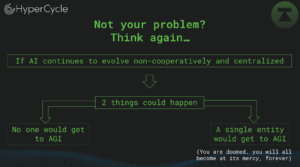

“In fact, if we don’t do anything, folks should be concerned,” says Saliba. “Really concerned. The internet of AI can certainly reduce the risk if properly secured, and that’s precisely our focus.”
Saliba also notes that “we aren’t here to scare people, we’ve done that, time to act” we are partaking in building solutions that can be extremely secure, profitable, and scalable. “All three are necessary.”
Saliba says that security is paramount and that it is incumbent upon him and others aiming to bring about the future that inevitably involves AI in nearly every facet of human lives to make sure that it improves the world and doesn’t bring about its end. He adds: “everyone can play a role and the irrefutable reality [you will be remembered] for your actions from here on out, including not taking one”
“Security by construct is paramount,” explained Saliba. “We must all take action now to partake in building a secure AI for future generations and for the future period.”
Saliba says that as of March 2023, HyperCycle is already servicing a number of companies across a range of sectors, mainly computing centers, so his approach is already working its way into the internet’s ecosystem as we speak. This, he explains, is where the internet of AI is inevitably headed, and HyperCycle is at the head of this charge.
“Cooperative AI is the next big thing,” explains Saliba. “Folks may change its name because of EGO or branding or whatnot, or it may take off as the internet of AI, [but] it is inevitable. Like it or not, it will happen.”
“We are introducing it.”
Christopher Plain is a novelist, comedian, and Head Science Writer at The Debrief. Follow and connect with him on Twitter, learn about his books at plainfiction.com, or email him directly at christopher@thedebrief.org.
HyperCycle sponsored the publication of this article.


![]()
![]()
